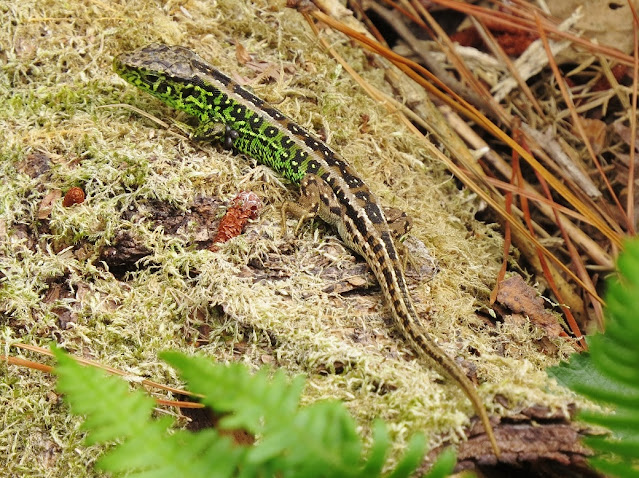Tuesday 16 April 2024
 |
| Sand Lizard - Higher Hyde Heath, Dorset |
After enjoying the Early Spider Orchids at Dancing Ledge (see post here) I decided to visit one of my favourite sites for reptiles in Dorset - Higher Hyde Heath. The Dorset Wildlife Trust, which manages this reserve (details here - opens in new window), says that it holds all six species of native UK reptile, although I have yet to see Adder or Smooth Snake here. While I was lucky to get a brief view of a Slow Worm on the present visit (my first of the year), the main attraction was this magnificent Sand Lizard Lacerta agilis (above).
As an aside, I strongly suspect that the often-quoted "six native UK reptiles" statistic is wrong. There are thriving populations of (Common) Wall Lizard Podicaris muralis in several Dorset locations, and there is a growing view that they might be native as well - see the Amphibian and Reptile Conservation website here (opens in new window) for example. Wall Lizards certainly look very much at home in Dorset; one for a separate blog post, I think. [Update May 2025: It now seems well established that most Wall Lizard colonies in Britain have been deliberately introduced - see my more recent blog on Wall Lizards.]
Anyway, Sand Lizards are a protected species in the UK (under both the Wildlife and Countryside Act 1981 and The Conservation of Habitats and Species Regulations 2017 - at time of writing), as of course are their habitats. This includes protection from disturbance. In this case, the lizard was hunting insects on a pile of tiles - it almost snagged a resting Bee Fly - and barely noticed my presence. I was able to take photographs from a short distance away using a zoom lens. This is a known Sand Lizard viewing location; another reptile enthusiast was lying down next to a nearby pile of tiles when I arrived, and two more visitors turned up while I was there.
 |
| Sand Lizard - Higher Hyde Heath |
The green flanks of this Sand Lizard show that he is a male. The colour gets more intense during the breeding season. Sand Lizards have a rather chunky look compared with the sleeker, and considerably more common, Viviparous Lizard Zootoca vivipara. The Sand Lizard UK range is incredibly patchy – essentially Dorset/New Forest, the Thames Basin Heaths and an area in the north west around the Mersey and Dee estuaries. Within Europe their distribution is also less than universal: they are largely absent from Iberia and Italy and although present in France, they seem to avoid French coastal areas. They are however found in Denmark, south Sweden and part of the Netherlands. Really, it is a mainly Central European species.
This is not my first Sand Lizard encounter at Higher Hyde Heath, so I'll end with images of another equally handsome male taken in May 2017. Note, by the way, the nasty cluster of ticks behind the front leg of this animal (see enlarged lower photo). These are almost certainly Common Ticks Ixodes ricinus, a known parasite of Sand Lizards (and indeed humans), and a health hazard to people and reptiles alike.
 |
| Sand Lizard with ticks - Higher Hyde Heath May 2017 |
 |
| Sand Lizard tick infestation - detail |
No comments:
Post a Comment